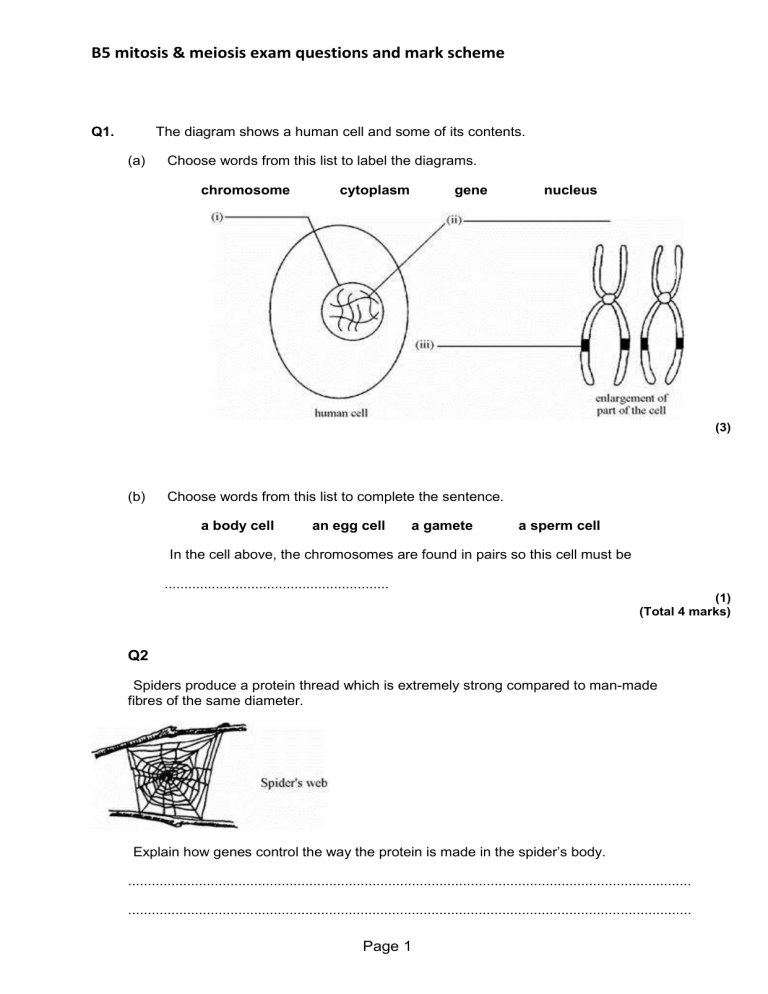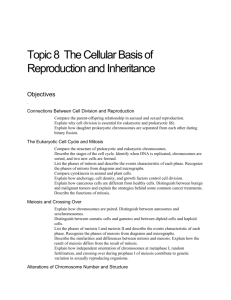B5 mitosis & meiosis exam practice and mark scheme

B5 mitosis & meiosis exam questions and mark scheme
Q1.
The diagram shows a human cell and some of its contents.
(a) Choose words from this list to label the diagrams. chromosome cytoplasm gene nucleus
(3)
(b) Choose words from this list to complete the sentence. a body cell an egg cell a gamete a sperm cell
In the cell above, the chromosomes are found in pairs so this cell must be
.........................................................
(1)
(Total 4 marks)
Q2
Spiders produce a protein thread which is extremely strong compared to man-made fibres of the same diameter.
Explain how genes control the way the protein is made in the spider’s body.
...............................................................................................................................................
...............................................................................................................................................
Page 1
B5 mitosis & meiosis exam questions and mark scheme
...............................................................................................................................................
...............................................................................................................................................
...............................................................................................................................................
(Total 4 marks)
Q3.
Diagram 1 shows the nucleus of a body cell as it begins to divide by mitosis.
Diagram 1
(a) Use a word from the box to label Diagram 1 . alleles chromosomes gametes
(b) Complete Diagram 2 to show what the nucleus of one of the cells produced by this mitosis would look like.
Diagram 2
(1)
Page 2
(1)
B5 mitosis & meiosis exam questions and mark scheme
(c) Stem cells from a recently dead embryo can be grown in special solutions.
Some facts about stem cells are given below.
• Stem cells from an embryo can grow into any type of tissue.
• Stem cells may grow out of control, to form cancers.
• Large numbers of stem cells can be grown in the laboratory.
• Stem cells may be used in medical research or to treat some human diseases.
• Patients treated with stem cells need to take drugs for the rest of their life to prevent rejection.
• Collecting and growing stem cells is expensive.
Use only the information above to answer these questions.
(i) Give two advantages of using stem cells.
1 ........................................................................................................................
...........................................................................................................................
2 ........................................................................................................................
...........................................................................................................................
(2)
(ii) Give two disadvantages of using stem cells.
1 ........................................................................................................................
...........................................................................................................................
2 ........................................................................................................................
...........................................................................................................................
(2)
(Total 6 marks)
Page 3
B5 mitosis & meiosis exam questions and mark scheme
Q4.
Diagram 1 shows the nucleus of a cell at the start of meiosis.
Diagram 1
(a) Name structure A . ......................................................................................................
(1)
(b) During meiosis, the nucleus shown in diagram 1 will divide twice to form four nuclei.
Complete diagram 2 to show the appearance of one of these nuclei.
Diagram 2
Page 4
(2)
(Total 3 marks)
B5 mitosis & meiosis exam questions and mark scheme
Q5.
The diagram shows three types of cells in a life history of a simple animal.
(a) How do the chromosomes of the body cells compare with the chromosomes in the fertilised egg from which they came?
....................................................................................................................................
....................................................................................................................................
(1)
(b) Describe what happens to chromosomes in the nucleus of a body cell when it forms reproductive cells.
....................................................................................................................................
....................................................................................................................................
....................................................................................................................................
....................................................................................................................................
....................................................................................................................................
(4)
(Total 5 marks)
Page 5
B5 mitosis & meiosis exam questions and mark scheme
Q6.
(a) How many pairs of chromosomes are there in a body cell of a human baby?
.....................................................................................................................................
(1)
(b) Place the following in order of size, starting with the smallest, by writing numbers 1 – 4 in the boxes underneath the words.
(1)
(c) For a baby to grow, its cells must develop in a number of ways.
Explain how each of the following is part of the growth process of a baby.
(i) Cell enlargement
..........................................................................................................................
(1)
(ii) The process of cell division by mitosis
..........................................................................................................................
..........................................................................................................................
..........................................................................................................................
..........................................................................................................................
..........................................................................................................................
..........................................................................................................................
(3)
(d) Why is cell specialisation (differentiation) important for the development and growth of a healthy baby from a fertilised egg?
.....................................................................................................................................
.....................................................................................................................................
(2)
(Total 8 marks)
Page 6
B5 mitosis & meiosis exam questions and mark scheme
Q7.
The drawing shows some of the stages of reproduction in horses.
(a) (i) Name this type of reproduction .......................................................................
(ii) Name the type of cell labelled A .....................................................................
(1)
(1)
(b) Name the type of cell division taking place at the stage labelled:
(i) B ......................................................................................................................
(ii) C ......................................................................................................................
(2)
(c) How does the number of chromosomes in each cell of the embryo compare with the number of chromosomes in cell A ?
.....................................................................................................................................
(1)
Page 7
B5 mitosis & meiosis exam questions and mark scheme
(d) When the foal grows up it will look similar to its parents but it will not be identical to either parent.
(i) Explain why it will look similar to its parents.
...........................................................................................................................
...........................................................................................................................
(1)
(ii) Explain why it will not be identical to either of its parents.
...........................................................................................................................
...........................................................................................................................
...........................................................................................................................
(2)
(Total 8 marks)
Q8.
The diagram shows two patterns of cell division. Cell division type A is used in gamete formation. Cell division type B is used in normal growth.
Page 8
B5 mitosis & meiosis exam questions and mark scheme
(a) Name the two types of cell division, A and B , shown in the diagram.
Type A ........................................................................................................................
Type B ........................................................................................................................
(2)
(b) Name the process in which an egg and sperm join together.
.............................................................................................................................
........
(1)
(c) Cell 1 contains 46 chromosomes. How many chromosomes will there be in:
(i) cell 10 ; ..............................................................................................................
(1)
(ii) cell 14 ?
.............................................................................................................
(1)
(Total 5 marks)
Mark scheme below
Page 9
B5 mitosis & meiosis exam questions and mark scheme
M1.
(a) (i) nucleus
(ii) chromosome
(iii) gene each for 1 mark
(b) a body cell for 1 mark
3
1
M2.
idea
• (gene) in DNA (i.e. mention of DNA)
• (DNA) contains bases
• (bases) code for amino acids (in protein)
• (amino acids) in correct order
• to make the (spider) protein any four for 1 mark each
(No credit for double helix, pairs of bases - but no penalty)
M3.
(a) chromosomes
(b) diagram showing four separate chromosomes two long and two short
(as in diagram 1) allow each chromosome shown as two joined chromatids
Page 10
1
[4]
[4]
B5 mitosis & meiosis exam questions and mark scheme do not allow if chromosomes touching each other
(c) (i) any two from:
• can grow into any type of tissue / named tissue
• used in medical research
• used to treat human diseases
• large numbers can be grown
(ii) any two from:
• expensive
• grow out of control / ref cancers
• may be rejected
• need for drugs (for rest of life)
M4.
(a) chromosome accept chromosomes
(b) drawing shows:
just 2 chromosomes
one long + one short
Page 11
1
2
2
[6]
1
1
1
[3]
B5 mitosis & meiosis exam questions and mark scheme
M5.
(a) idea
identical (do not allow simply “the same number”) for 1 mark
(b) idea chromosomes double/duplicate/copies made for 1 mark separate into 2 sets/divide* gains 1 mark
but separate into 4 sets/divide twice* gains 2 marks number halved compared to bodycell or single set (only) 16 accept in terms of cells but only if chromosomes referred to in first and/or last items) for 1 mark
M6.
(a) 23
(b) chromosome nucleus gene cell
2 3 1 4
(c) (i) any one from
(cells which are bigger) take up more space
Page 12
1
4
[5]
1
1
B5 mitosis & meiosis exam questions and mark scheme
(cells) have to get bigger or mature to divide
(ii) chromosomes duplicate or make exact copies of self accept forms pairs of chromatids
1 nuclei divide accept chromatids or chromosomes separate
1 identical (daughter) cells formed accept for example, skin cells make more skin cells or cells are clones
(d) any two from
Differentiation mark babies need or are made of different types of cells or cells that have different functions accept different cells are needed for different organs
Division or specialisation mark as fertilised egg starts to divide each cell specialises to form a part of the body accept specialised cells make different parts of the body
Growth mark specialised cells undergo mitosis to grow further cells accept cells divide or reproduce to form identical cells
2
1
1
M7.
(a) (i) sexual / sex
Page 13
[8]
B5 mitosis & meiosis exam questions and mark scheme
(ii) egg / gamete / sex cell / ovum ( reject ovule) for 1 mark each
2
(b) (i) meiosis / reduction
(ii) mitosis / somatic for 1 mark each
(c) twice as many ( reject answers based on 23 / 46 chromosomes) for one mark
1
2
(d) (i) information / genes / DNA passed from parents
(chromosomes neutral) for one mark
1
(ii) genes / genetic information / chromosomes from two parents alleles may be different environmental effect / named may have been mutation any two for 1 mark each
M8.
(a) A = meiosis accept ‘mieosis’ do not accept ‘miosis’
B = mitosis do not accept ‘meitosis’ etc
2
[8]
1
1
Page 14
B5 mitosis & meiosis exam questions and mark scheme
(b) fertilisation allow conception
(c) (i) 23
(ii) 46
1
1
1
[5]
Page 15









